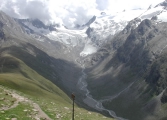 |
|
|
|
|
|
|
Where and when do glaciers occur? Glaciers accumulate wherever there is a surplus of snowfall over
snowmelt for enough years to allow the consolidation of snow into ice.
Given a specific threshold of thickness (which varies according to the slope) the ice starts to move downslope.
The pressure of the moving ice, together with the loose material it picks up, erode the
land surface and scour the bedrock beneath the glacier and the slopes at the glaciers margins. Glaciers occur in a wide range of arctic and alpine environments. Most cold areas
of the world show signs of having been eroded by glaciers at intervals of between 20,000 and 50,000
years. So this type of disturbance acts on a very different time scale, compared to the others
described in this unit. Furthermore, it operates on a very large scale and affects alpine
environments in all parts of the world. |
1 - Rotmoosferner
|
|
Rock glaciers Rock glaciers develop where there are particularly thick accumulations of rocky debris e.g. on large talus slopes, and when low soil temperatures cause meltwater to seep into the pores in the debris and freeze. The ice filling the pores in the debris allows a glacier-like movement of the debris, producing long tongues of broken rock. |
29 August 2011 |
||
| |
||

